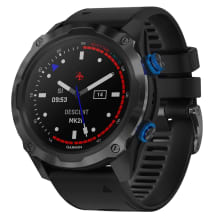Pros
-
Great battery life
-
Easy to navigate
-
Heart rate underwater
Cons
-
Too bulky for everyday use
But you know what? It's also a smartwatch. With its large, colorful display, the Descent MK2i is easy to read both on land and in the water. Its giant display and case make this smartwatch a bit large for everyday wear, for most people. But if you can manage its bulk, the Garmin Descent MK2i is a brilliant wearable. Want to check your heart rate? The MK2i has your data. Need to quantify your stress level? Garmin has a number for that. Curious about your menstruation cycle? This smartwatch and the Garmin Connect app have your back. Where the Garmin shines, however, is in its ability to take an accurate heart rate while underwater. It’s a rare feature that we’ll talk about, below.

The Garmin Descent MK2i is a premium smartwatch for performing rigorous physical activity, GPS navigation, playing music and more.
Prepare your fingers for tapping the Descent’s buttons, since the scroll-down list of sports on the watch is vast. In addition to the common sports like running, strength, yoga, and breathwork, the Descent also includes multiple dive-specific modes including apnea, apnea hunt (with no fish-startling beeps,) multi-gas, and a closed circuit dive rebreather monitoring option.
Thanks to a module that attaches to your dive regulators, this air-integrated smartwatch can also record the wearer’s air consumption underwater. This helpful data is viewable in the dive logs found in the Garmin Dive app. If you’re curious about your air consumption, the app includes an average air pressure per minute statistic as a helpful shorthand for comparing consumption during different dives. Additionally, the Garmin Dive app also tracks on a map the beginning and end points of dives, giving you a visual reference of your dive for the shoreline and its topography. The Descent MK2i is a tool that will serve recreational scuba divers well, from their most basic training to the most technical dives in the depths they undertake.
About the Garmin Descent MK2i

Paired with the Descent T1 transmitter, users can to monitor air tank pressure, track remaining air supply and overall air consumption while down below.
Garmin Descent MK2i specs
- Dimensions: 2.05 x 2.05 x 0.70 inches
- Weight: 3.66 oz
- Display: Sunlight-visible, transflective memory-in-pixel (MIP)
- Water Rating: 328 feet
- Battery Life: smartwatch 16 days; 80 hours in dive mode
- Sensors: Pulse Ox Blood Oxygen Saturation, Heart Rate, Barometric Altimeter, Compass, Gyroscope, Accelerometer, Thermometer, Depth Sensor
- Connectivity: Bluetooth, GPS, GLONASS, GALILEO
- Warranty: One year
What we like
Battery Life
Everyone wants their gear to work with minimal fuss. Longer battery life means less time on the charger. Garmin’s wearables are known for their longevity between charges. The Descent continues that legacy, boasting a battery life of 16 days in smartwatch mode and 80 hours in dive mode. Using some features will drain your battery quickly, like playing music. Music can be stored directly on the Descent (from your collection or via the Spotify app) and played via Bluetooth. Expect six hours of juice between charges if you’re doing this.
With the GPS active, your battery should last about two days, so be mindful of that feature if you are on a multi-day live-aboard diving trip or a multi-day through-hike without your charger. Using Expedition GPS mode will get you through about 15 days of battery use. The Descent MK2i uses a different charger than Garmin’s other wearables; a unique clamp to connect to the watch and USB. The clamp is sturdy, making it unlikely to be bumped off accidentally while charging.
Reliable Mapping
During testing, the maps provided by Garmin for the Descent MK2i proved detailed, showing both land features (roads, businesses) and underwater depths (bathymetric info, the underwater version of topographic maps) to give a better sense of the underwater world you’re exploring. Even as a dive professional, bathymetric maps are not something I’ve used often. I was surprised at how useful having the information right at my fingertips was. It provided me a sense of where different ridgelines were, which is very helpful for orientation and making more educated guesses as to the marine life I might see, based on depth. I found that some of the dive locations I explored during testing were even named: a helpful detail.
That said, out of 30 dives I took the Descent MK2i while testing it, about a third did not accurately map to the shoreline entrance I used. Shore dives—a dive where you walk into the water from shore—proved the least accurate, and often showed my dive starting further out in the water. There were instances where the Descent MK2i didn’t record both my entrance and exit points. That’s a bummer if you had a great dive and want to find the same route into the water again. However, on dives that started by falling off the back of a boat, the Descent MK2i stated the location where my dive started and where I surfaced.
Underwater Heart Rate

Garmin's Descent app collects in-depth data for divers—including underwater heart and breath rate monitoring.
If knowing your heart rate during a dive is something you’re excited about, this Garmin has it. Unlike many competitors, the Descent MK2i continues to track your heart rate while underwater and gives you a graphed representation of your heart rate during a dive in addition to your max and min. Knowing when your heart is pumping a bit faster and being able to calm yourself is exceptionally useful in diving: a faster heart means heavier breathing, resulting in a shorter dive. Aside from gas density (think of Boyle’s law) and increased gas consumption at depth,) your breathing rate is one of the few aspects that you can control in terms of extending your dive. If you can keep your heart rate lower, generally, you’re relaxed and breathing less.
Using the Descent MK2i for all your fitness activities—on land or under the water—will give you a complete picture of your fitness. Garmin digs into some nitty gritty tests, like your performance condition and functional threshold power. I found the smartwatch’s acute load feature was a helpful reminder when I was planning the activities for the rest of my day, after diving. Since it can be easy to discount the effort your body makes during a dive: as it’s not an activity that feels as strenuous as a run or a lifting session, over-exerting through more exercise on land post-dive can easily happen. When I saw how Garmin estimated my load, it was a good reminder to go easier for the rest of the day.
What we don’t like
Large as a barge
I’m not a petite person and this watch covered the width of my wrist and caught easily on the cuff of shirtsleeves. Its heft was noticeable for the first few days I was wearing it, as well. But after a few days of wearing it constantly, its weight became easier to ignore. That said, the Descent MK2i’s size serves a purpose. As someone who is in the age range where progressive lenses become more common, I appreciated the extra screen space, underwater, as all of the metrics I care about are easy to see on its ample display. On land? I’m less impressed. It simply feels like too much watch. There’s a smaller 48 mm version of the Garmin MK2i. However, it lacks the air integration of the model we tested.
Should you buy the Garmin Descent MK2i?

Frequent divers will appreciate the key details included on the Descent MK2i when it comes to unique physical activity.
Yes, if you’re an enthusiastic diver who also needs a smartwatch
For divers, the Garmin Descent MK2i’s features outweigh its large size—if you need a new dive computer, this wearable is worth your time. This device’s long battery life is a great feature, for any smartwatch. And, if you’re curious about how your fitness and dive time interact, the Descent Mk2i will give you all the data you could hope for.
That said, If you already have a dive computer with air integrated, the Descent MK2i is a harder sell. While cool, GPS tracking is not going to be helpful for most divers: if most of your dives are with charted boats, someone else is doing the navigating. So, knowing the GPS coordinates for your dive site is moot.

Track your most rigorous physical activity, on land and sea, with ease while wearing the Garmin Descent MK2i.
Meet the tester

Rebecca Boniface
Contributor
Rebecca Boniface is a certified PADI dive instructor, full-time nomad, and DIY enthusiast.
Checking our work.
Our team is here to help you buy the best stuff and love what you own. Our writers, editors, and experts obsess over the products we cover to make sure you're confident and satisfied. Have a different opinion about something we recommend? Email us and we'll compare notes.
Shoot us an email


